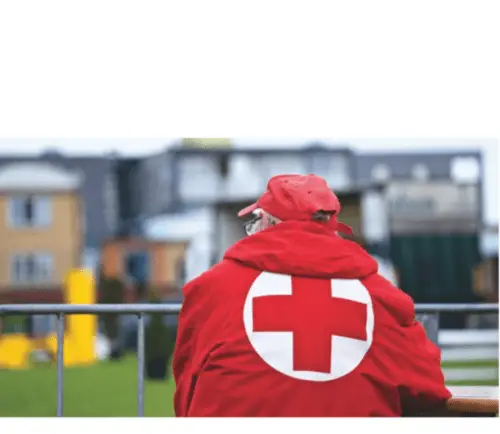This post covers the full Red Cross blood donation history and that of the Redcross with their roles in blood donation campaigns.
For some reason I usually imagine an emergency scenario where urgent blood donation is needed to save lives; like in a car crash or similar accidents where there is a massive loss of blood in the victims. It is in such situations that we all remember the importance of the Red Cross Blood donation drives and other similar campaigns.
In many regions of the world, I have come to observe through research that there is still a huge gap between those who are willing to donate blood and or its products and those who even though are apparently healthy, still have some reservations as to why they do not take part in free-will non-remunerated blood donation.
This gap is found more mostly in third-world countries, as statistics from the International Federation of the Red Cross (IFRC) have shown that at least half of every blood donated each year comes from high-resource countries.
Although one may still argue that this result could be attributed to a lot of factors like;
- Lack of information and enlightenment on issues of blood donation in the low economic countries. In fact, this is a major culprit for the blood donation myths and facts in such regions.
- Lack of food of high nutritional value is essential for blood donation.
- Poor infrastructure and lack of equipment like blood banks make processing and preservation of blood and its products more efficient, and many others.
You will also like; All you need to know before your first-time blood donation experience
Before we deviate so much from the topic at hand; Red cross Blood donation History and Facts, let us quickly look at the origin/history of Blood Donation.
Table of Contents
- A Brief History of Blood Donation
- The Red Cross Blood Donation History
- 1. Origin of Red Cross
- 2. The Founding of the British Red Cross
- 3. Development of Blood Vacuum
- 4. The First National Red Cross Blood Donation Service
- 5. The 13 Million Pints of Blood
- 6. The First Red Cross Blood Collection Center
- 7. Establishment of the American Red Cross Regional Blood Centers
- 8. Blood Collection Agency for Military in the Korean War
- 9. National Blood Clearing House
- 10. National Blood Registry for Rare Blood Types
- 11. The National Blood Policy of 1972
- 12. Testing of Newly Donated Blood in 1985
- 13. Holland Laboratory for Biomedical Research
- 14. The First National Laboratory
- The Red Cross Blood Donation Campaigns Today
- How the Red Cross Donated Blood is Distributed Today
- Why We don’t Hear Much Again about the Red Cross Blood Campaigns
- You Can Still Join the Blood Donation Programs
- Conclusion
A Brief History of Blood Donation

Blood donation history is dated as far back as the 17th century.
What we know today as blood donation also called blood transfusion was first carried out successfully between two dogs in the year 1665 by an English scientist (Physician) named Richard Lower.
This experiment by Richard Lower is the very recorded attempt of blood donation both in animals and man.
But before then, another English Physician named William Harvey was the first person to discover that a fluid called blood circulated in our body in the year 1628.
Furthermore, the first recorded successful blood donation and transfusion was conducted under the supervision of James Blundell in 1818, where human blood was used in the treatment of postpartum hemorrhage.
Also, in 1840, whole blood transfusion was used successfully in the treatment of hemophilia.
Red Cross blood donation history began in the year 1859 just as an idea from Henry Dunant; a Swiss man who after witnessing a bloody battle scene in Italy, in the city of Solferino between Imperial Austria and Franco-Sardinian.
The Swiss man organized a group of people living in the village where the war took place, to take care of the soldiers who were injured in the war where they were treated for their wounds, and was as well given food, comfort, and shelter.
Moreover, the official Red cross we know today was formed in the year 1863 by the same Dunant, along with five other men from Geneva. The six set up an international committee to give relief to the wounded.
This was followed by the successful discovery of the ABO blood group system by Karl Landsteiner in the year 1900. Two years later, the colleagues of Landsteiner named Alfred Decastello and Adriano Sturli further went ahead to discover a fourth blood type; Group AB.
Another breakthrough in the history of blood donation was the discovery of Blood Group O as a Universal blood type in 1907. This was great news and was only possible after an attempt to start blood typing and cross-matching to ensure the safety of blood transfusions.
In 1914, the first anti-coagulant was discovered by Adolf Hustin. This was before the major heat of the first world war and made it possible for donated blood to last longer on the battlefields.
This committee which was founded by Henry Dunant in 1863 later grew to be what is now known today as the International Committee of the Red Cross (ICRC) in the year 1919 in Paris after the first world war
The hospital of Leningrad was the first to ever have a blood bank. This was official in the year 1932.
Another blood group known as the Rhesus (Rh) Blood Group was discovered in the year 1939-1940. This was found to be the culprit for many adverse reactions associated with blood transfusions.
Furthermore, the first country to ever establish a nationwide blood donation and collection program was the United States. This was in the year 1940.
Initially, glass bottles were used in the collection of donated blood and its storage, but in the year 1950, they were replaced by the plastic bags we see today as they are easier and safer to use.
Platelets were discovered to reduce bleeding in the year 1961 after it was used in Cancer patients who were experiencing severe hemorrhage.
Also, in 1970 voluntary blood donation kicked off gradually and Hepatitis B Surface Antigen (HBsAg) was tested for in blood donors in 1971. Followed by the discovery of apheresis in the year 1972; a process that helps one separate one blood component from another thereby preserving the rest.
The screening of blood donors for HIV was first done using a surrogate test in the year 1983, by Standford Blood Center
This was followed immediately by the screening for HIV in blood banks in 1985.
Also, Human T-Lymphocytic Virus Type I (HTLV-1) which is known to cause Leukaemia in adults first started at Stanford Blood Center in the year 1987.
Finally, in the year 1990, the test for Hepatitis C was first discovered, followed by the discovery of West Nile Virus as a transfusion-transmissible infection in 2002.
In all this history, the Red Cross blood donation campaign was involved.
The Red Cross Blood Donation History
Most of the breakthroughs above listed in the history of blood donation are unrelated to the Red Cross Society.
1. Origin of Red Cross
The Red Cross Blood donation History just as mentioned above, started in 1863 after Dunant and the 5 men from Geneva set up a community to give reliefs to injured soldiers on the battlefield.
This gave birth to what is popularly known as the Geneva convention of which was officially adopted in 1864.
2. The Founding of the British Red Cross

The British Red Cross was founded in the year 1905.
It was formerly known as the “British National Society for Aid to the Sick and Wounded in War”; a body formed to give aid and relief to the victims of the Franco-Prussian War in the 19th Century.
The organization gave aid to both fighting enemies, and they were protected by the red cross emblem on the battlefield.
The Royal charter for the British Red Cross society was issued to them in 1908 by His Majesty King Edward VII, while Queen Alexandria became the first president of the British Red Cross.
3. Development of Blood Vacuum
The next event which is closely linked to the blood donation history was the development of the blood vacuum container by John Elliott which is currently being used by the Red cross.
This was in the year 1940.
4. The First National Red Cross Blood Donation Service
This massive campaign was first done in the United States under the supervision of Dr. Charles R. Drew (M.D). This drive was geared to help donate blood for the Military of the United States.
The campaign was called the National Blood Donor Service, and it was during the war at Pearl Harbour in Japan.
Also, in the same war, albumin; a protein that is contained in blood plasma in abundance was used to treat soldiers who were suffering from shock.
World war II also witnessed another positive impact of the Red Cross blood donation services in 1944, where the dried plasma was used to treat wounded soldiers.
5. The 13 Million Pints of Blood
During the 2nd world war, the Red Cross blood donation drive yielded over 13 million pints of blood.
This marked the end of the blood donation drive by the Red Cross during the 2nd world war.
6. The First Red Cross Blood Collection Center
This was set up in Rochester, New York City in the United States of America in the year 1948.
It was the very first national blood program for civilians.
7. Establishment of the American Red Cross Regional Blood Centers
This was made of 1,500 blood banks in various hospitals and 31 regional blood centers. It was established in the year 1949.
8. Blood Collection Agency for Military in the Korean War
In the Korean war, the Red Cross services were used during Korean War in the year 1950. This initiative was from the United States and was put in place when they interfered with the Korean war.
9. National Blood Clearing House
This was founded in the year 1956.
10. National Blood Registry for Rare Blood Types
The registry was set up to collect and store blood from those who have very rare blood types.
There are some blood types that occur in one in every 200 persons, so the Board Governors of the American National Red Cross, joined the national headquarters to host a national rare blood donor registry.
11. The National Blood Policy of 1972
This officially put an end to paid blood donations in the United States following a panel set up by the government in 1974 to encourage standard practices. The drive was pioneered by the Red cross.
12. Testing of Newly Donated Blood in 1985
The practice where newly donated blood was tested before being administered to patients was pioneered by the Red cross in 1985.
This was motivated by the move of the Food and Drug Administration agency to license the test which detects antibodies to HIV.
13. Holland Laboratory for Biomedical Research
The Red Cross branch in Holland opened a medical laboratory in the year 1987 which served the purpose of conducting biomedical research.
14. The First National Laboratory
The first national laboratory for the Red Cross Blood products was opened in the year 1992 at Dedham, Mass.
To date, there have been a series of advancements in modern technology that have been favoring the Red Cross blood donation campaigns globally. All these advancements have been enriching history.
The Red Cross Blood Donation Campaigns Today
It may surprise you that yearly, there are over 108 million blood donations going on globally.
And out of this, more than 34 million (31%) of these donations come from the Red Cross campaigns.
It is only possible because of the International Federation of the Red Cross and Red Crescent.
This organization is currently established in many countries of the world, and over 60 of these countries get their blood, based almost completely on voluntary non-remunerated blood donations.
The Red Cross blood drive also ensures that voluntary donors pass all the blood donation requirements, and are certified as eligible for blood donation before they can donate blood.
How the Red Cross Donated Blood is Distributed Today

It is a paradox as to how a nation that sponsors wars still carter for the needs of injured soldiers of the enemies. In the past, the proceeds from the Red Cross blood donation drives go almost completely to the army, and it’s kept for use during wars.
But as the needs of humanity have been gradually shifting from the fight against each other to the collective fight against diseases, the campaigns are now tailored to meet sick people who are in need of blood and its products.
Just like every other scarce resource, blood and its products are very rare even with the millions of blood donated each year.
So the blood gotten from the red cross blood drives is distributed based on needs and the severity of medical and surgical cases.
The severity of such medical and surgical cases is not the same for every country.
For instance, in places like Sub-saharan Africa where one of the major killer diseases is Malaria which is transmitted by the female Anopheles mosquito, especially in children, the focus of the red cross is on such children who are suffering from such illnesses.
This is for no other reason other than that Severe Malaria is a major cause of anemia in children who are below the age of 5 years, which in turn has a very high mortality rate if not treated on time.
So over 65% of the blood donated to the Red Cross goes to children with severe anemia associated with malaria.
On the other hand, in places like Australia, the table below summarizes how the Blood is distributed by the Red Cross;
| Percentage (%) | Uses |
| 34 | Blood-related diseases and cancer |
| 19 | Anemia and its causes |
| 18 | Surgeries especially Open heart Surgeries and Burns |
| 13 | Medical Problems like heart, stomach, and kidney diseases |
| 10 | Orthopedic cases like fractures and joint replacements |
| 4 | Pregnant women, new mothers, children |
| 2 | Road accidents and trauma |
Also, Read; the various blood charts and their significance.
Why We don’t Hear Much Again about the Red Cross Blood Campaigns
In most countries of the world, the Organization of the Red Cross and Red Crescent are posed with challenges needing creative ideas to circumvent, like being affected by the government’s rules and regulations.
This is not lost on nations whose systems may be crowded by inactive and corrupt officials.
So because the Red Cross blood campaign is being supervised and overseen in such countries by their government, there is usually a lag in the response to blood donation drives and campaigns due to some of the reasons below:
- Too many protocols associated with government response to the crisis in many countries. In some countries, for a property owned by the government to respond to any situation at all, there is usually a need for approval by a government official assigned to oversee such.
- Corrupt government officials in some countries may embezzle the funds dedicated to sponsoring the campaigns.
- There are poor incentives and recognition given to voluntary non-remunerated blood donors especially in many third world countries, etc.
See the available blood banks in Nigeria in the various states
You Can Still Join the Blood Donation Programs
In places where things work, there are campaigns and Blood drives going on to enlighten people, and demystify some myths associated with blood donation.
One of the main factors that discourage people from donating blood is centered on the myths of blood donation.
It may sound weird, but some people still have lots of misconceptions about the whole process of blood donation. And the only way this could be corrected is to fuel blood donation campaigns in different targets to enlighten people.
Such enlightenment campaigns can help answer some crucial questions like:
- Who cannot Donate Blood?
Moreover, you can always join the Red Cross Blood donation programs and help save a life by visiting their website: redcross.org.
Conclusion
The Blood donation history is a very rich one. With many periods of breakthroughs that are worth remembering.
Kindly note that there was no remuneration of any sort given to the author of this post. This article is a product of well-refined research with a passion for blood donation and its campaigns.
Other Posts You May Like:



